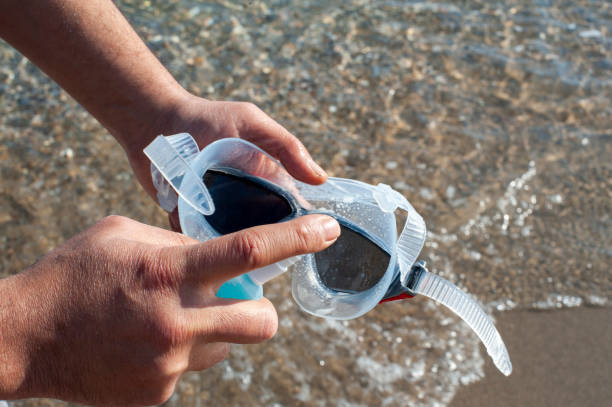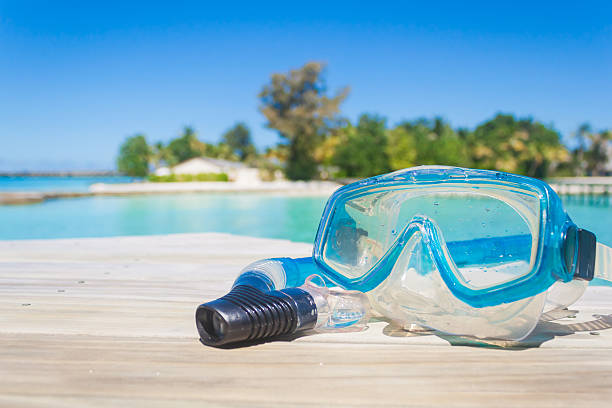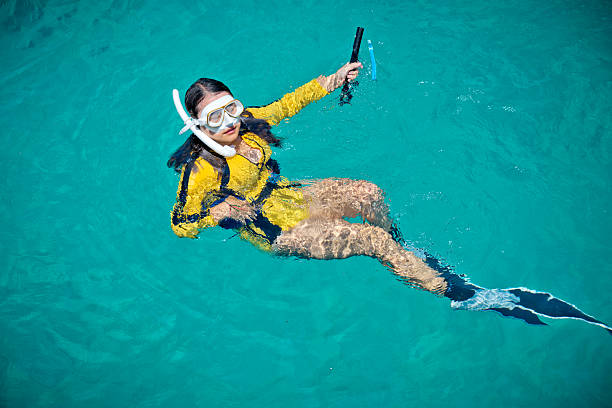Ein Schnorchelabenteuer ist wie die Entdeckung einer Schatzkammer voller Unterwasserwunder. Doch neben der faszinierenden Unterwasserwelt und dem kristallklaren Wasser ist Sicherheit oberstes Gebot. In diesem umfassenden Leitfaden erfahren Sie, wie Sie sicher schnorcheln und wie wichtig Sicherheit ist. Von den Vorteilen des Schnorchelns mit den richtigen Vorsichtsmaßnahmen bis hin zu wichtigen Sicherheitstipps vermittelt dieser Artikel allen Interessierten das nötige Wissen und die nötige Aufmerksamkeit, um die Tiefen sicher und entspannt zu erkunden. Begleiten Sie uns auf einer Reise durch die faszinierende Welt des sicheren Schnorchelns und sorgen Sie für unvergessliche Unterwassererlebnisse für alle.
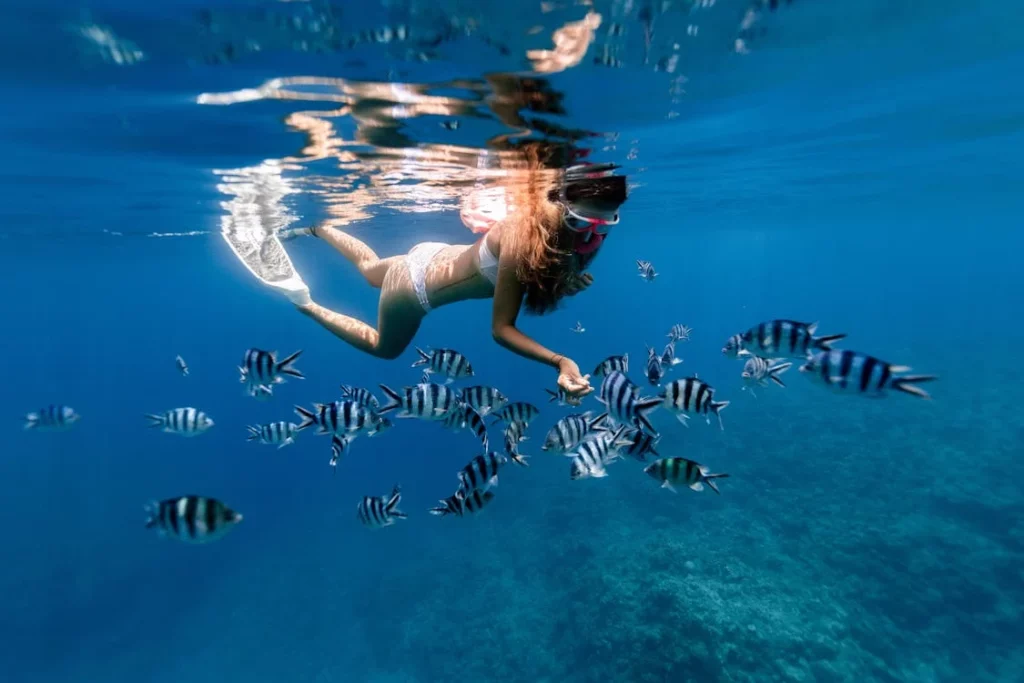
Bereiten Sie die richtige Ausrüstung zum Schnorcheln vor
Bevor Sie sich auf ein Unterwasserabenteuer begeben, müssen Sie die richtigen Schnorchelausrüstung ist der grundlegende Schritt zu mehr Sicherheit und Spaß. Statistiken zeigen, dass eine gut sitzende Maske das Leckagerisiko um 85 % reduziert, während gut geformte Flossen die Schwimmleistung um 30 % steigern. Hochwertige Ausrüstung erhöht den Komfort, reduziert Ermüdungserscheinungen und optimiert Ihr Schnorchelerlebnis.
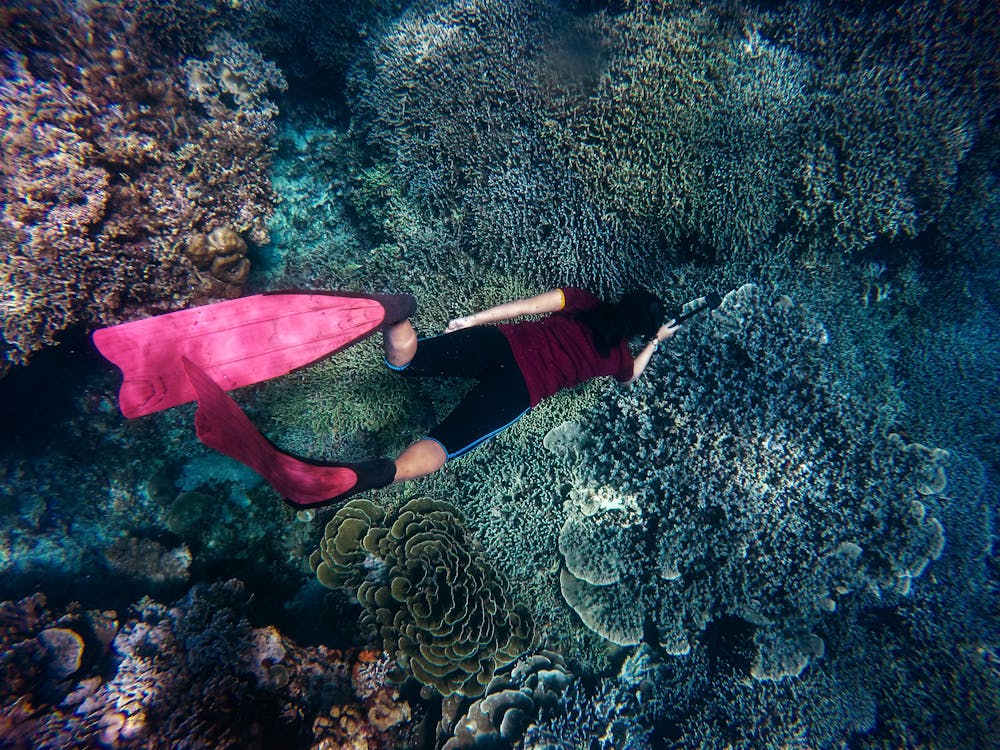
Eine bequeme Maske
Eine gut sitzende Maske dient nicht nur der Sicht, sondern ist ein wichtiges Sicherheitselement. Eine gut abgedichtete Maske verhindert das Eindringen von Wasser und sorgt so für klare Sicht und ungestörte Erkundungen unter Wasser.
Kauftipps: Achten Sie bei der Auswahl einer Maske vor allem auf die Passform. Stellen Sie sicher, dass sie eng an Ihrem Gesicht anliegt, ohne Druckstellen zu verursachen. Wählen Sie eine Maske mit weichem Silikonrand, der sich Ihren Gesichtskonturen anpasst und wasserdicht abschließt. Testen Sie die Maske, indem Sie sie ohne Band leicht an Ihr Gesicht drücken. Wenn sie an Ort und Stelle bleibt, sitzt sie wahrscheinlich gut.
Ein richtig sitzender Schnorchel
Der Schnorchel ist nicht nur ein Atemgerät, sondern eine Lebensader. Ein richtig sitzender Schnorchel erleichtert das Atmen, reduziert Ermüdungserscheinungen und erhöht den Komfort während des Schnorchelns.
Kauftipps: Wählen Sie einen Schnorchel mit einem bequemen Mundstück, das sicher zwischen Zähnen und Lippen sitzt. Achten Sie darauf, dass die Schnorchellänge Ihrer Körpergröße entspricht, damit die Spitze des Schnorchels beim Schwimmen mit dem Gesicht nach unten über Wasser bleibt. Achten Sie auf Merkmale wie Ausblasventile oder Spritzschutz, um das Eindringen von Wasser zu verhindern und eine ungehinderte Atmung zu gewährleisten.
Stromlinienförmige Flossen
Flossen dienen nicht nur dem Vortrieb; sie sind auch für Manövrierfähigkeit und Sicherheit unerlässlich. Stromlinienförmige Flossen ermöglichen effiziente Bewegung, sparen Energie und ermöglichen Schnorchlern, Strömungen mühelos zu meistern.
Kauftipps: Achten Sie bei der Wahl Ihrer Flossen auf Komfort, Passform und Leistung. Wählen Sie Flossen mit verstellbaren Riemen, um die Passform individuell anzupassen und Wundscheuern oder Blasen vorzubeugen. Wählen Sie Flossen aus leichten und dennoch strapazierfähigen Materialien wie hochwertigem Gummi oder Silikon. Achten Sie auf das Flossenblattdesign: Längere, schmalere Flossenblätter bieten einen effizienteren Vortrieb, während kürzere Flossenblätter für bessere Manövrierfähigkeit auf engstem Raum sorgen.
Erfahren Sie mehr über Wetter- und Wasserbedingungen
Das dynamische Zusammenspiel von Wetter und Wasserbedingungen ist entscheidend für sichere und angenehme Schnorchelausflüge. Untersuchungen zeigen, dass 70 % der Schnorchelunfälle auf mangelnde Kenntnis der Wetter- und Wasserbedingungen zurückzuführen sind. Die Überprüfung der Wettervorhersage und die Beurteilung der Wassersichtweite können das Risiko gefährlicher Situationen deutlich reduzieren und so ein sicheres und angenehmes Unterwassererlebnis gewährleisten.
Wettervorhersagen prüfen
Bevor Sie Ihre Ausrüstung anlegen, informieren Sie sich über zuverlässige Wettervorhersagen. Plötzliche Stürme oder starke Winde können ruhige Gewässer in turbulente See verwandeln und selbst für erfahrenste Schnorchler eine Gefahr darstellen.
Bewerten Sie die Sichtweite im Wasser und die Gezeiten
Um die Sichtweite zu beurteilen, achten Sie auf klares, durchsichtiges Wasser, das eine gute Sicht anzeigt. Trübes oder trübes Wasser hingegen kann aufgrund von Sedimenten oder Algen eine schlechte Sicht bedeuten. Überprüfen Sie außerdem die Gezeitenkarten, um Richtung und Stärke der Gezeitenströmungen zu verstehen und so eine sichere Navigation zu gewährleisten und Gefahren zu vermeiden. Planen Sie Ihre Schnorchelausflüge bei optimaler Sicht und minimaler Gezeitenströmung für ein sichereres Unterwassererlebnis.
Erkennen Sie gefährliche Meereslebewesen
Das Erkennen gefährlicher Meereslebewesen ist entscheidend, um potenziell gefährliche Begegnungen beim Schnorcheln zu vermeiden. Einige Beispiele für gefährliche Meereslebewesen sind:
- Qualle: Der Kontakt mit bestimmten Quallenarten kann zu schmerzhaften Stichen führen, die Hautreizungen, allergische Reaktionen oder sogar schwerwiegendere gesundheitliche Probleme verursachen.
- Seeigel: Wenn man auf Seeigel tritt oder sie versehentlich streift, können schmerzhafte Stichwunden entstehen, die, wenn sie nicht sofort behandelt werden, häufig zu Entzündungen und Infektionen führen.
- Stachelrochen: Stachelrochen besitzen einen giftigen Stachel an ihrem Schwanz, den sie zur Selbstverteidigung einsetzen können, wenn sie von Schnorchlern bedroht oder versehentlich getreten werden. Muränen: Obwohl sie nicht aggressiv sind, können Muränen beißen, wenn sie provoziert werden oder wenn Schnorchler ihren Verstecken zu nahe kommen, was zu tiefen Wunden und möglichen Infektionen führen kann.
- Rotfeuerfische: Feuerfische haben giftige Stacheln, die bei Berührung schmerzhafte Stiche verursachen können. Ihr auffälliges Aussehen mag Schnorchler anlocken, aber Vorsicht ist geboten, um zufällige Begegnungen zu vermeiden.
- Haie: Haiangriffe auf Schnorchler sind zwar selten, bestimmte Haiarten können jedoch an bestimmten Orten ein Risiko darstellen. Das Verständnis des Haiverhaltens und das Meiden bekannter Hai-Aktivitäten kann dazu beitragen, das Risiko von Begegnungen zu minimieren.
Wenn Sie sich dieser potenziellen Gefahren bewusst sind und vorbeugende Maßnahmen ergreifen, wie z. B. Kontakt vermeiden, einen Sicherheitsabstand einhalten und den Lebensraum der Meereslebewesen respektieren, können Sie das Verletzungsrisiko beim Schnorcheln erheblich verringern.
Berücksichtigen Sie die körperliche Gesundheit
Eine gute körperliche Fitness, ausreichende Flüssigkeitszufuhr und das Bewusstsein für persönliche Grenzen sind wichtige Elemente für Ihr Wohlbefinden bei der Erkundung der Unterwasserwelt.
Sorgen Sie für körperliche Fitness
Eine ausreichende körperliche Fitness ist unerlässlich, um Schnorchelabenteuer durchzuhalten und zu genießen. Studien haben gezeigt, dass Personen mit einer besseren Herz-Kreislauf-Fitness bei Wasseraktivitäten wie Schnorcheln weniger Müdigkeit verspüren und eine bessere Ausdauer haben.
Daher ist regelmäßiges Herz-Kreislauf- und Krafttraining wichtig, um Ausdauer und Durchhaltevermögen zu verbessern und längere Unterwasseraktivitäten ohne Ermüdung zu gewährleisten. Achten Sie außerdem auf ausreichende Flüssigkeitszufuhr und ausgewogene Ernährung, um Ihren Körper für optimale Leistung und Belastbarkeit bei körperlicher Anstrengung zu stärken. Darüber hinaus ist eine ausreichende Flüssigkeitszufuhr und Ernährung vor, während und nach dem Schnorcheln entscheidend, um den Elektrolythaushalt wieder aufzufüllen und Dehydration vorzubeugen, die unter Wasser zu Muskelkrämpfen und Erschöpfung führen kann.
Kennen Sie Ihre Grenzen und gesundheitlichen Einschränkungen
Seien Sie ehrlich zu sich selbst, was Ihre Schwimmfähigkeiten, Ihre Ausdauer und eventuelle Vorerkrankungen angeht, die Ihre Unterwasserleistung beeinträchtigen könnten. Respektieren Sie die Signale Ihres Körpers und vermeiden Sie es, Ihre Komfortzone zu verlassen, um Unfälle oder medizinische Notfälle beim Schnorcheln zu vermeiden.
Notiz*: Personen mit Atemwegserkrankungen wie Asthma oder Herzerkrankungen sollten vor der Teilnahme an Schnorchelaktivitäten ihren Arzt konsultieren.
Meistern Sie Schnorcheltechniken
Die richtige Technik steigert Ihren Komfort und Ihre Effizienz und reduziert das Unfallrisiko deutlich. Wir vertiefen uns in die Grundlagen des Schnorchelns, beginnend mit der effektiven Atmung.
Richtige Atemmethoden
Die richtige Atemtechnik ist beim Schnorcheln unerlässlich. Das Atmen durch einen Schnorchel erfordert ruhige, kontrollierte Atemzüge, um das Einsaugen von Wasser zu vermeiden. Üben Sie, langsam und tief durch den Mund einzuatmen, die Lungen zu füllen und dann vollständig auszuatmen. Diese rhythmische Atmung sorgt für eine gleichmäßige Sauerstoffzufuhr, reduziert Müdigkeit und hilft Ihnen, entspannt zu bleiben.
Techniken für effektives Atmen
Effektive Atemtechniken umfassen mehr als nur die Grundlagen. Für optimale Leistung sollten Sie Ihre Atmung mit Ihren Bewegungen koordinieren. Atmen Sie beim Schwimmen langsam und bewusst. Wenn Sie unter die Oberfläche tauchen müssen, atmen Sie tief ein und halten Sie die Luft an. Atmen Sie beim Auftauchen sanft aus. Diese Technik spart Energie und verhindert, dass Wasser in den Schnorchel eindringt.
Tipps zur Vermeidung von Hyperventilation
Hyperventilation kann schnell zu Schwindel und Panik führen, die beim Schnorcheln gefährlich sind. Um dies zu vermeiden, konzentrieren Sie sich auf eine langsame und gleichmäßige Atmung. Vermeiden Sie schnelle, flache Atemzüge, die den Kohlendioxidgehalt senken und Ihren Atemrhythmus stören können. Wenn Sie außer Atem geraten, halten Sie an, lassen Sie sich treiben und nehmen Sie sich einen Moment Zeit, um Ihre Atmung zu regulieren, bevor Sie weitermachen.
Effizientes Schwimmen und Bewegung verstehen
Effizientes Schwimmen und Bewegen sind entscheidend, um Energie zu sparen und beim Schnorcheln in unterschiedlichen Wasserbedingungen zu navigieren. Wenn Sie diese Fähigkeiten beherrschen, können Sie länger und sicherer auf Entdeckungsreise gehen. Wir entdecken wichtige Strategien zur Verbesserung Ihrer Unterwassermobilität.
Tipps zum Energiesparen
Nutzen Sie optimierte Bewegungen, um den Widerstand zu verringern, und halten Sie Ihren Körper horizontal und dicht an der Oberfläche. Setzen Sie Ihre Flossen effizient ein, indem Sie mit minimaler Kniebeugung aus der Hüfte treten. Das maximiert den Vortrieb und minimiert die Ermüdung. Üben Sie außerdem entspannte, rhythmische Schwimmzüge, um ein gleichmäßiges Tempo zu halten, ohne sich zu überanstrengen.
Manöver bei unterschiedlichen Wasserbedingungen
Unterschiedliche Wasserbedingungen erfordern angepasste Manövriertechniken. Halten Sie in ruhigen Gewässern ein gleichmäßiges, sanftes Tempo und gleiten Sie mühelos mit den Flossen. Bei unruhigem oder turbulentem Wasser sollten Sie kräftigere, gezieltere Tritte einsetzen, um der Strömung entgegenzuwirken. Achten Sie beim Navigieren durch Riffe oder felsige Gebiete auf präzise, kontrollierte Bewegungen, um Kollisionen zu vermeiden und die empfindliche Meeresumwelt zu schützen.
Klares Wasser aus Ihrem Schnorchel
Ein vollgelaufener Schnorchel kann ein angenehmes Schnorchelerlebnis schnell in einen panischen Kampf verwandeln. Zu wissen, wie man Wasser aus dem Schnorchel entfernt, ist für die Sicherheit unter Wasser unerlässlich.
Methoden zum Reinigen eines überfluteten Schnorchels
Es gibt mehrere effektive Methoden, einen vollgelaufenen Schnorchel zu reinigen. Bei der Druckmethode atmet man kräftig in den Schnorchel aus, um das Wasser oben herauszudrücken. Alternativ kann man bei der Verdrängungsmethode den Kopf nach hinten neigen und das Wasser beim langsamen Einatmen natürlich ablaufen lassen. Beide Techniken sind wichtig, damit Ihr Schnorchel sauber und funktionsfähig bleibt und Sie schnell wieder normal atmen können.
Bei Wassereintritt Ruhe bewahren
Bleiben Sie ruhig, wenn Wasser in Ihren Schnorchel eindringt, um Panik zu vermeiden und eine effektive Reinigung zu gewährleisten. Wenn Sie spüren, dass Wasser eindringt, hören Sie auf zu schwimmen, bleiben Sie in entspannter Schwimmposition und wenden Sie die von Ihnen gewählte Reinigungsmethode an. Panik kann zu Hyperventilation und Desorientierung führen. Daher ist es für ein sicheres Schnorchelerlebnis unerlässlich, sich einen Moment Zeit zu nehmen, um sich zu beruhigen und die Atmung zu kontrollieren.
Treffen Sie beim Schnorcheln Sicherheitsmaßnahmen
Sicherheitsmaßnahmen sind entscheidend für ein sicheres und angenehmes Schnorchelerlebnis. Eine der effektivsten Sicherheitsstrategien ist die Nutzung des Buddy-Systems und die Gewährleistung einer angemessenen Aufsicht. Lassen Sie uns untersuchen, warum diese Praktiken unerlässlich sind.
Buddy-System und Supervision
Schnorcheln mit einem Partner, auch Buddy-System genannt, erhöht die Sicherheit deutlich. Ein Schnorchelpartner kann bei Ausrüstungsfehlern, Ermüdung oder medizinischen Notfällen sofort Hilfe leisten und so das Unfallrisiko reduzieren. Zusätzlich kann die Aufsicht durch einen erfahreneren Schnorchler oder einen professionellen Guide die Sicherheit weiter erhöhen, indem er Anleitung gibt, die Bedingungen überwacht und umgehend auf auftretende Probleme reagiert. Ein Partner und die richtige Aufsicht schaffen ein Sicherheitsnetz, das Ihnen ein sicheres und sorgenfreies Schnorcheln ermöglicht.
Notfälle erkennen und bewältigen
Das Erkennen und der richtige Umgang mit Notfällen sind für sicheres Schnorcheln unerlässlich. Auf unerwartete Situationen vorbereitet zu sein, kann den Unterschied zwischen einem kleinen Zwischenfall und einem schweren Unfall ausmachen. Wir zeigen Ihnen, wie Sie Anzeichen von Not erkennen, im Notfall die richtigen Maßnahmen ergreifen und Hilfe signalisieren.
Anzeichen von Not erkennen
Häufige Anzeichen sind schnelle oder unregelmäßige Atmung, hektische oder unkoordinierte Bewegungen, übermäßige Müdigkeit und sichtbare Panik. Wenn Sie eines dieser Anzeichen bemerken, ist es wichtig, schnell zu handeln und Hilfe zu leisten. Bleiben Sie wachsam und schauen Sie regelmäßig nach Ihrem Schnorchelpartner, um sicherzustellen, dass es ihm gut geht.
Schritte im Notfall
Bleiben Sie im Notfall ruhig und befolgen Sie diese Schritte:
- Stoppen und schweben: Beenden Sie sofort alle anstrengenden Aktivitäten und lassen Sie sich auf dem Rücken treiben, um Energie zu sparen und den Auftrieb aufrechtzuerhalten.
- Signal für Hilfe: Verwenden Sie die üblichen Handzeichen oder rufen Sie Ihren Tauchpartner oder Schnorchler in der Nähe um Hilfe.
- Unterstützen Sie Ihren Kumpel: Wenn dein Tauchpartner in Not ist, gehe ruhig auf ihn zu und biete ihm Unterstützung an. Halte ihn über Wasser und ermutige ihn zu langsamen, tiefen Atemzügen, um Panik zu vermeiden.
- Aus dem Wasser: Helfen Sie dem Schnorchler in Not gegebenenfalls, sicher aus dem Wasser zu kommen. Verwenden Sie Schwimmhilfen oder bitten Sie bei Bedarf andere um Hilfe.
Wie signalisiert man um Hilfe?
Effektive Kommunikation ist in Notfällen unerlässlich. Nutzen Sie diese Methoden, um Hilfe zu signalisieren:
- Handzeichen: Strecken Sie einen Arm gerade nach oben und bewegen Sie ihn von einer Seite zur anderen, um Ihre Notlage anzuzeigen.
- Pfeife: Tragen Sie eine wasserdichte Pfeife bei sich und nutzen Sie diese, um mit kurzen, scharfen Tönen Aufmerksamkeit zu erregen.
- Buddy-Systemsignale: Vereinbaren Sie vor dem Schnorcheln mit Ihrem Tauchpartner eine Reihe von Signalen. Dazu gehört beispielsweise, mit dem Kopf zu klopfen, um die Rückkehr an die Oberfläche anzuzeigen, oder eine geballte Faust, um zu signalisieren, dass Sie Hilfe benötigen.
- Notschwimmgerät: Setzen Sie, falls verfügbar, eine Notschwimmhilfe ein, um Hilfe zu signalisieren und für zusätzlichen Auftrieb zu sorgen.
Schützen Sie die Meeresumwelt
Schnorchler können die Meeresökosysteme schützen, indem sie einige wichtige Regeln beachten. Vermeiden Sie es, Korallenriffe zu berühren oder darauf zu stehen, da diese empfindlich und leicht beschädigt werden können. Verwenden Sie riffverträgliche Sonnencreme, um zu verhindern, dass schädliche Chemikalien ins Wasser gelangen. Achten Sie auf eine verantwortungsvolle Abfallentsorgung, indem Sie keinen Müll zurücklassen und den Müll aufheben, den Sie sehen. Halten Sie außerdem respektvollen Abstand zu Meerestieren, um deren natürliches Verhalten nicht zu stören. Unterstützen Sie lokale Naturschutzbemühungen und informieren Sie andere über die Bedeutung des Meeresschutzes. Mit diesen Regeln können Schnorchler die Schönheit des Ozeans genießen und gleichzeitig zu seinem Schutz beitragen.
Richtlinien für einen respektvollen Umgang mit Meereslebewesen
Halten Sie beim Schnorcheln respektvollen Abstand zu Meeresbewohnern. Vermeiden Sie es, Fische und andere Meeresbewohner zu jagen, zu berühren oder zu füttern. Das Beobachten aus der Ferne reduziert den Stress der Tiere und minimiert das Risiko schädlicher Interaktionen. Denken Sie daran: Wir sind Besucher in ihrem Zuhause, und unser Verhalten sollte Respekt und Fürsorge für ihr Wohlergehen widerspiegeln.
Korallenriffe nicht berühren oder stören
Korallenriffe sind empfindliche Ökosysteme, die durch menschlichen Kontakt leicht geschädigt werden können. Vermeiden Sie es, Korallen zu berühren oder darauf zu stehen, da dies zu irreversiblen Schäden führen kann. Schon eine leichte Berührung kann das fragile Gleichgewicht des Riffs stören und zum Ausbleichen oder Absterben von Korallenpolypen führen. Nutzen Sie die richtige Tarierung, um berührungsfrei durch die Riffe zu navigieren und so sicherzustellen, dass diese lebendigen Lebensräume für zukünftige Generationen erhalten bleiben.
Verwenden Sie riffsicheres Sonnenschutzmittel
Herkömmliche Sonnenschutzmittel enthalten Chemikalien wie Oxybenzon und Octinoxat, die für Korallenriffe schädlich sind. Entscheiden Sie sich für riffsichere Sonnenschutzmittel mit mineralischen Inhaltsstoffen wie Zinkoxid oder Titandioxid. Diese Alternativen bieten effektiven UV-Schutz, ohne Schadstoffe in die Meeresumwelt freizusetzen. Mit der Wahl riffsicherer Produkte tragen Sie zum Schutz der Korallenriffe und des Meereslebens bei.
Denken Sie an die Pflege nach dem Schnorcheln
Nach dem Schnorcheln ist es wichtig, Ihre Ausrüstung gründlich mit Süßwasser abzuspülen, um Salz, Sand und mögliche Verunreinigungen zu entfernen. Trocknen Sie Ihre Ausrüstung vollständig, vorzugsweise an einem schattigen Ort, um direkte Sonneneinstrahlung zu vermeiden, da diese das Material beschädigen kann. Überprüfen Sie alle Teile auf Beschädigungen, wie z. B. Risse im Maskenband, Risse im Schnorchel oder Flossen mit Abnutzungserscheinungen. Lagern Sie Ihre Ausrüstung an einem kühlen, trockenen Ort, um Schimmelbildung zu vermeiden. Regelmäßige Wartung, einschließlich des Austauschs verschlissener Teile, sorgt dafür, dass Ihre Ausrüstung in Top-Zustand bleibt und Sie jedes Mal ein sicheres und angenehmes Schnorchelerlebnis haben.
Geräte ordnungsgemäß reinigen und lagern
Reinigen Sie Ihre Ausrüstung nach jedem Schnorchelgang gründlich von Salz, Sand und Schmutz. Spülen Sie Maske, Schnorchel und Flossen mit Süßwasser ab und achten Sie dabei besonders auf die Ritzen, in denen sich Partikel ansammeln können. Verwenden Sie bei Bedarf milde Seife, um hartnäckige Rückstände zu entfernen. Die ordnungsgemäße Lagerung Ihrer Ausrüstung an einem kühlen, trockenen Ort verhindert Schäden durch längere Sonneneinstrahlung und Salz und erhält ihre Funktionalität.
Spülen und trocknen Sie Ihre Ausrüstung
Das Abspülen Ihrer Ausrüstung ist unerlässlich, um Korrosion und Abnutzung zu vermeiden. Lassen Sie Ihre Ausrüstung nach der Reinigung vollständig trocknen, bevor Sie sie verstauen. Hängen Sie Flossen, Maske und Schnorchel an einen gut belüfteten Ort, um eine vollständige Trocknung zu gewährleisten. Dieser Schritt beugt Schimmelbildung vor, die die Integrität Ihrer Ausrüstung beeinträchtigen und zu unangenehmen Gerüchen führen kann.
Auf Verschleiß prüfen
Die regelmäßige Überprüfung Ihrer Schnorchelausrüstung ist unerlässlich, um Verschleißerscheinungen zu erkennen und zu beheben. Überprüfen Sie Ihre Maske auf Risse oder beschädigte Dichtungen, den Schnorchel auf Verstopfungen oder Schäden am Mundstück und Ihre Flossen auf Risse oder geschwächte Riemen. Die rechtzeitige Behebung kleinerer Probleme kann Ausrüstungsausfälle bei Ihrem nächsten Schnorchelabenteuer verhindern und so Sicherheit und Zuverlässigkeit gewährleisten.
Abschluss
Schnorcheln, ein Tor zur faszinierenden Unterwasserwelt, bietet Abenteuerlustigen unvergleichliche Erlebnisse. Sicherheitsvorkehrungen zu treffen ist nicht nur ratsam, sondern unerlässlich, um den Spaß zu maximieren und Risiken zu minimieren. Wer sicheres Schnorcheln lernt und die beschriebenen Richtlinien beachtet, kann selbstbewusst auf Entdeckungsreise gehen und jahrelang unvergessliche Unterwasserabenteuer erleben.
Häufig gestellte Fragen
Was ist der Trick beim Schnorcheln?
Das Geheimnis eines gelungenen Schnorchelausflugs liegt in der Entspannung und dem Sparen von Energie. Schwimmen Sie gemächlich, atmen Sie tief und gleichmäßig, denken Sie nicht zu viel nach und genießen Sie jeden Moment des Abenteuers.
Wie atmet man unter Wasser mit einem Schnorchel?
Um mit einem Schnorchel unter Wasser zu atmen, positionieren Sie das Mundstück des Schnorchels zwischen Ihren Lippen und achten Sie darauf, dass es fest sitzt. Entspannen Sie Ihre Gesichtsmuskeln und atmen Sie langsam und gleichmäßig durch den Mund. Atmen Sie sanft aus, um das Wasser aus dem Schnorchel zu entfernen. Behalten Sie dabei einen gleichmäßigen Rhythmus bei, um ein angenehmes und effizientes Atmen zu ermöglichen.
Welche Sicherheitsmaßnahmen gelten beim Schnorcheln?
Zu den sicheren Schnorchelpraktiken gehören:
- Buddy-System: Schnorcheln Sie immer mit einem Partner, der im Notfall helfen kann.
- Bedingungen prüfen: Beurteilen Sie vor dem Betreten das Wetter, die Sicht im Wasser und die Gezeitenbedingungen.
- Respektieren Sie das Meeresleben: Vermeiden Sie es, Meerestiere zu berühren oder zu belästigen.
- Ausrüstung löschen: Erfahren Sie, wie Sie Wasser aus Ihrem Schnorchel und Ihrer Maske entfernen.
- Bleib ruhig: Bleiben Sie im Wasser entspannt und gelassen, um Energie zu sparen und Panik zu vermeiden.
Wie verhindert man Haiangriffe beim Schnorcheln?
Obwohl Haiangriffe selten sind, gibt es Vorsichtsmaßnahmen, um das Risiko zu verringern:
- Vermeiden Sie Dämmerung und Morgengrauen: Haie sind zu diesen Zeiten aktiver.
- Bleiben Sie in Gruppen: Größeren Menschengruppen nähern sich Haie seltener.
- Vermeiden Sie helle Kleidung: Tragen Sie neutrale Farben, um sich in die Umgebung einzufügen.
- Schwimmen Sie nicht in der Nähe von Angelgebieten: Vermeiden Sie Bereiche, in denen Fischer aktiv Fische fangen.
- Respektieren Sie das Meeresleben: Belästigen oder provozieren Sie keine Haie oder andere Meerestiere.
Ist Schnorcheln für Anfänger sicher?
Schnorcheln kann für Anfänger mit der richtigen Anleitung, Ausrüstung und Aufsicht sicher sein. Es ist wichtig, in ruhigen, flachen Gewässern zu beginnen, die Grundfertigkeiten zu üben und allmählich Selbstvertrauen aufzubauen. Anfänger sollten außerdem Sicherheitsrichtlinien beachten, z. B. mit einem Partner schnorcheln und in ihrem Komfortbereich bleiben.
Kann ich schnorcheln, wenn ich kein guter Schwimmer bin?
Ja, Sie können schnorcheln, auch wenn Sie kein guter Schwimmer sind. Halten Sie sich an flache, ruhige Gewässer, in denen Sie bei Bedarf stehen können. Verwenden Sie Schwimmhilfen wie Schnorchelwesten oder Schwimmnudeln für zusätzlichen Auftrieb. Üben Sie Atemtechniken und bleiben Sie zur Sicherheit in Ufernähe oder an einer Schwimmhilfe. Schnorcheln Sie immer mit einem Partner, der Ihnen bei Bedarf helfen kann.
Wer sollte nicht schnorcheln?
Personen, die sich im Wasser nicht wohl fühlen, Atemwegserkrankungen haben, die durch Schnorcheln verschlimmert werden könnten, oder die Sicherheitsrichtlinien nicht einhalten können, sollten vom Schnorcheln absehen. Darüber hinaus sollten Personen mit bestimmten Erkrankungen, wie z. B. unbehandelter Epilepsie oder Herzerkrankungen, vor dem Schnorcheln einen Arzt konsultieren.
